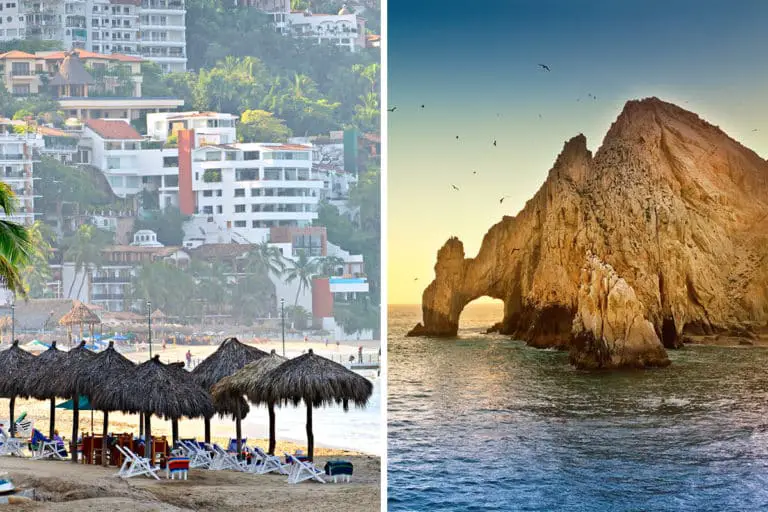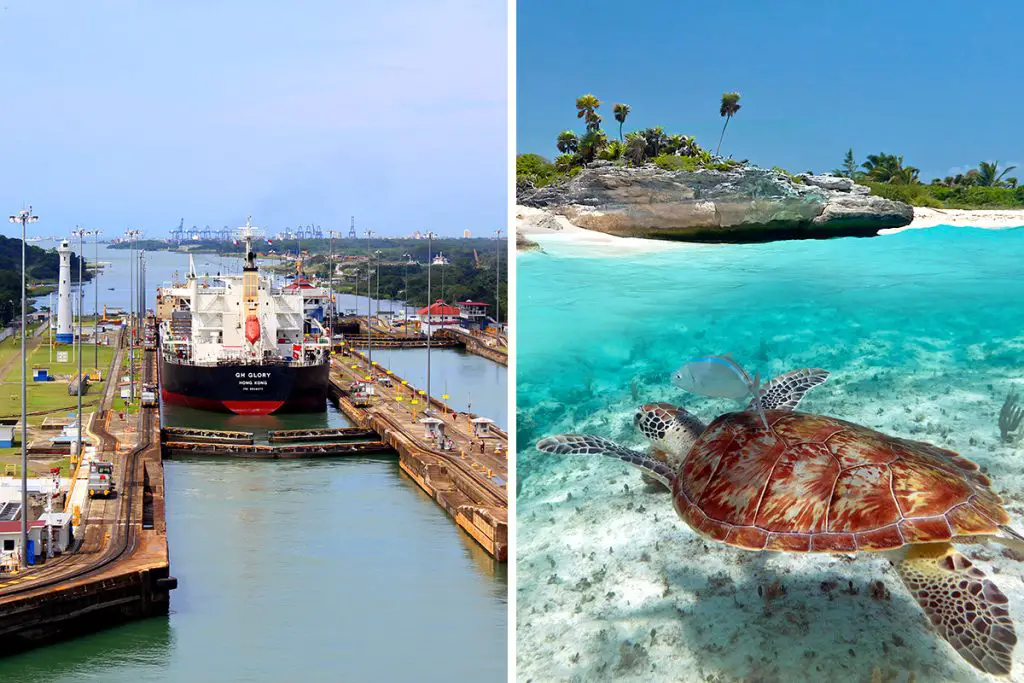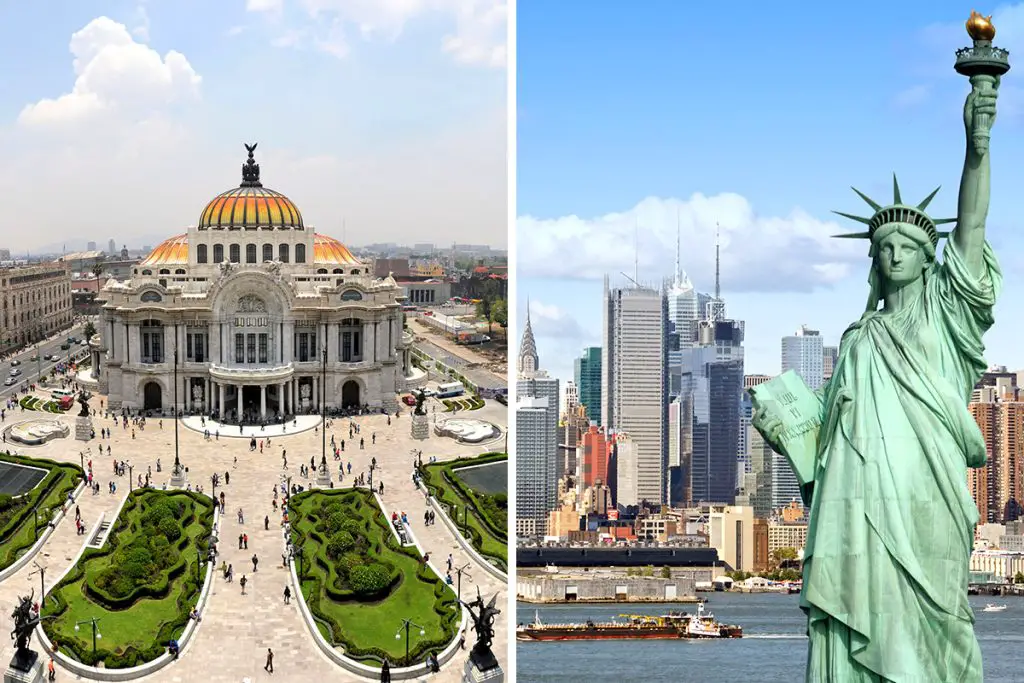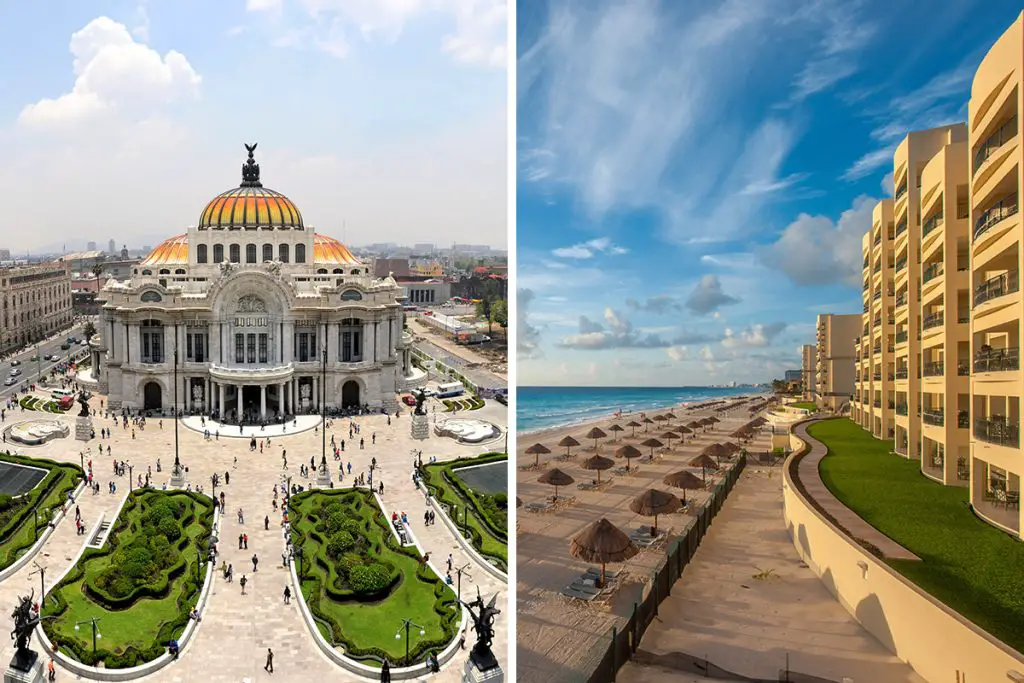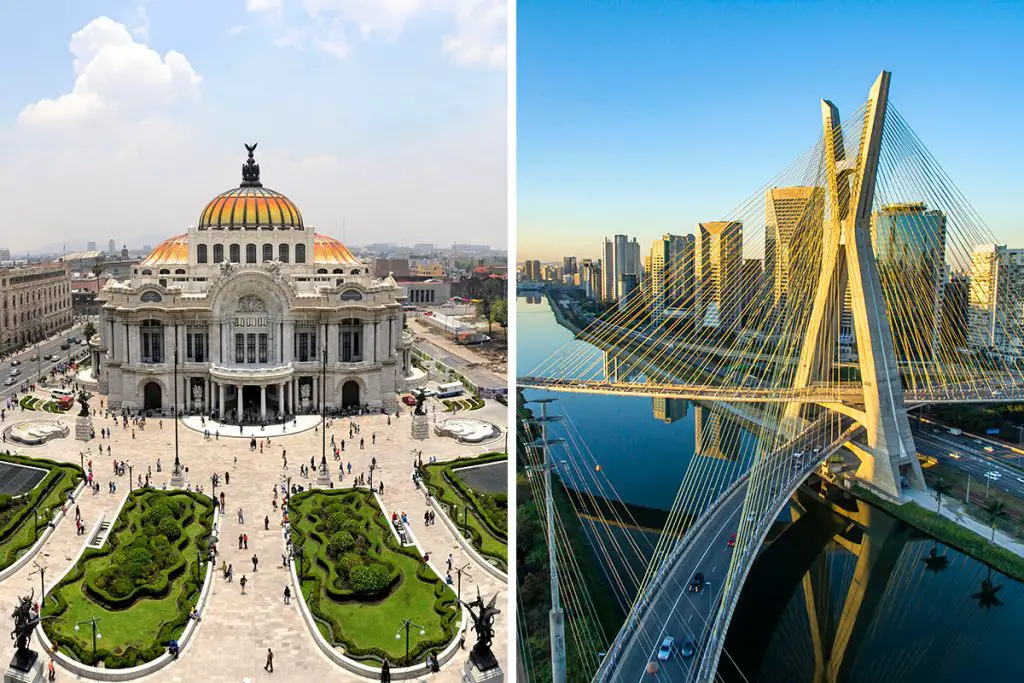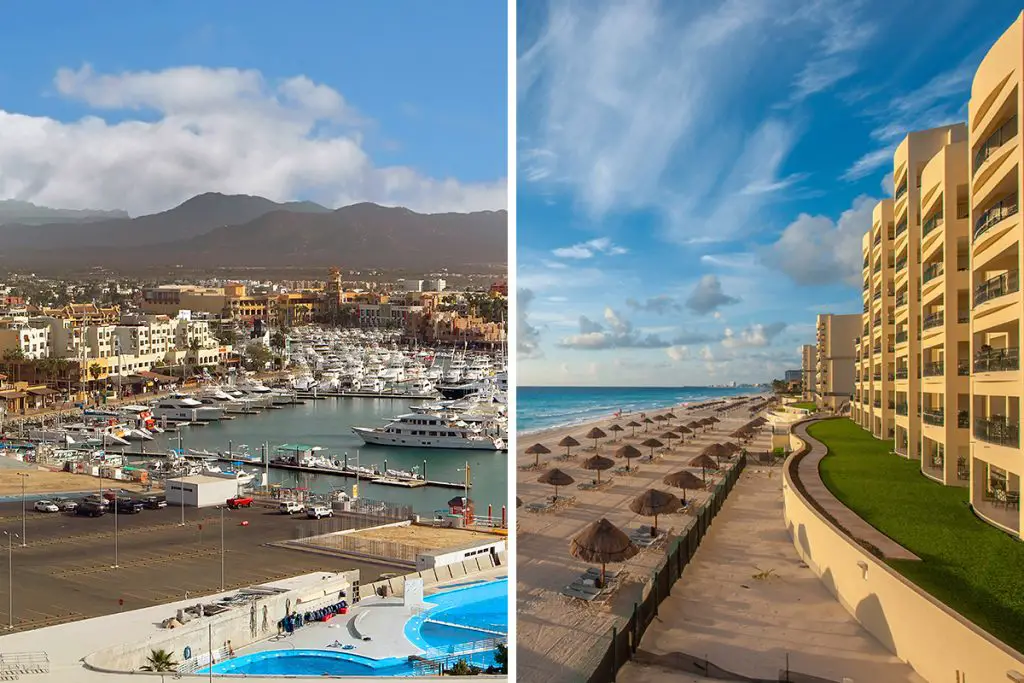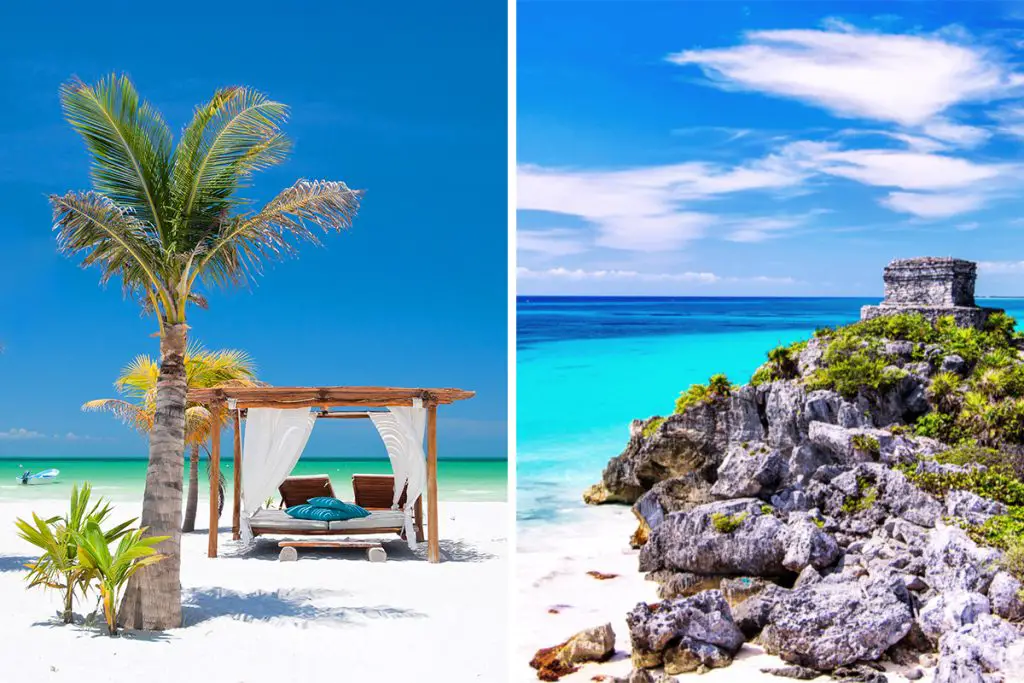Undoubtedly beautiful, and a bit quirky on their own, these two destinations will certainly throw in the right combination of fun, excitement, and variety.
Puerto Vallarta
Seaside cities are where Mexican tourism of the spirited kind is at. And one such spot, which at one point in time was called “The Friendliest City in the World,” lies on Mexico’s Pacific coast, within the borders of the Mexican state of Jalisco.
This resort city is thick with cultural and traditional themes, from creative expression in art galleries to multicolored Huichol arts and crafts to impressive displays of talent in sculptures and street murals. And then there are its customary festivals that you should strive to join. With all that, there is no shortage of relevant experiences to be had in Puerto Vallarta.
Of course, the beaches are a staple in any seaside city. Playa Camarones, Playa de los Muertos, Boca de Tomates are but some of what the city has to offer. Whether you value accessibility, crowds, or seclusion, there is always an option in Puerto Vallarta.
What Makes Puerto Vallarta Unique?
The Hollywood Charm
Puerto Vallarta is no stranger to the magnetism that Mexico’s destinations exert on even the most decorated celebrities. Richard Burton and Elizabeth Taylor debatably started the trend of Hollywood’s incursion into this patch of paradise, all thanks to their 1963 movie The Night of the Iguana.
Because of the high-profile visits of these jet setters, Puerto Vallarta has exploded in fame to the point that everybody wants a piece of it … literally. Real estate tourism has boomed over the years, even until the present. Whether this is a good thing or a bad thing, only time will tell.
The City’s Beachside Heart
As the city’s heart beats, tourism’s lifeblood flows along the meandering edges of the esplanade overlooking the vastness that is the Pacific. By simply shuffling your feet along the Malecon, most of the city’s charisma is laid bare for you to stop and investigate further.
You can find a sexy pier, stretches of sun-kissed sands strewn with swaying palms, brightly colored stalls selling souvenirs and snacks, and spectacular street performances, among other special stuff.
Submarine Residents
Not only does Puerto Vallarta draw crowds of tourists, it irresistibly attracts congregations of marine creatures. You shouldn’t miss out on being part of the breathtaking experience of viewing them from a good distance away and letting them do their thing. Or even better, you can try swimming safely alongside these majestic creatures.
The list of large sea life conducting their business here is pretty impressive — sharks, dolphins, whale sharks, giant mantas. And if wild encounters cause too much anxiety for you, you can get into marine centers that cater to humane and regulated interactions; there is a smattering of them around Puerto Vallarta.
Magic Towns
Pueblos Magicos are towns where the “magic” of the place is thick in the air and takes hold of you. If you take raw beauty, cultural wealth, and historical significance in isolation or in combination, you have yourself a so-called Mexican Magic Town.
These Magic Towns offer extreme sports, ecotourism, festivals, and adventures, to name a few. And in Puerto Vallarta, you can come across a few of these magical whereabouts —
Sayulita
Sayulita is not your everyday, average sleepy town. It has got cobblestone streets with papel picado overhead and flanked with colored facades, manicured palms, peddlers of a hodge-podge of trinkets, and stalls selling wares and providing tours.
And then there’s the magical aspect of the gifted natural biosphere that supports a wealth of flora and fauna that you can interact with at your leisure through organized encounters.
Tequila
The first thing that probably popped in your head is tequila the drink. You are spot on!
The magic of this town stems from the fields of agave plants, local distilleries, and the history of this potent spirit. Its agave landscape and ancient industrial facilities have even made it into the UNESCO World Heritage arena. That is more than enough to classify Tequila as magical.
Feel free to relax in a romantic corner of the town or in one of its intriguing tequila bars serving a plethora of tequila-based cocktails while admiring how a truly adaptable liquor tequila really is. If you are in the right place at the right time, you might even get serenaded by a mariachi.
Cabo
Cabo is Mexico’s diamante, ever sparkling, ever drawing the stars — be it celebrities or private people (like yourself). It surely embellishes the Mexican west coast with star power, the like of which rivals even the Caribbean powerhouses on Mexico’s east side.
The municipality has an assortment of full-service resorts with world-class beaches suitable for even the most hardcore of water-sporting activities or the most laid-back touring of attractions dotting the gilded coastline. It cannot be understated how much entertainment can be experienced on this side of Mexico.
What Makes Cabo Unique?
The Los Cabos Trio
You cannot fully experience Los Cabos without touring it from end to end. You can start off with the old-world charms of San Jose del Cabo, followed by traipsing the sunshiny sand of The Corridor, and finally, wrapping up the complete Cabo experience in Cabo San Lucas’ first-class marina, aka Golden Zone.
Cabo San Lucas
Enjoy your Mexican Chocolate Clam and wash your palate with some clamato or damiana liqueur while watching the fancy yachts and cruise ships moor in the harbor, at arm’s length from your spot on the esplanade. Cabo San Lucas is, without a doubt, brimming with lavishness, perhaps exuding a sense of privilege and exclusivity.
But it does not mean the humble budgeteer is set aside, on the contrary, the place has got relatively cheap all-you-can-eats, budget and moderately-priced bistros, and fairly inexpensive lodgings situated within walking distance from the hot spots. Don’t expect any seaside views or extravagant facilities, though.
Below are a few value joints and spaces that you can take advantage of:
Crazy Lobster Bar & Grill, El Peregrino, Alcaravea Gourmet — with eats less than an average of $15 a set.
Los Milagros Hotel, The Bungalows Hotel, Tesoro Los Cabos — all sites less than $100 a night.
San Jose del Cabo
Nothing beats the simple charms of the traditional Mexican lifestyle replete with historical and cultural references. Streets paved with stone, plastered brick buildings with clay barrel-tile roofs, and commanding churches, all very much reminiscent of Spanish colonial architecture. And if you come on an eventful month, you can see the colorful flags strung across the streets, waving as you pass by.
San Jose del Cabo is best explored with the sandals on your feet. Start off your sightseeing tour at the Plaza Mijares, surrounded by enchanting restaurants and shops selling curios for that sought-after souvenir. And if you just want to sit back and relax until the sun sets, there are playas nearby with a worthwhile and soothing view of the sea.
The Corridor
The absolutely complete solution for all beach and water sports lovers, the Los Cabos Corridor boasts Blue Flag beaches and balnearios along its stretch of flamboyant coast that beckons even Hollywood VIPs.
You can choose from a variety of activities: snorkeling and dive tours, fishing expeditions, various water sports, casual golf matches, and so much more on the coastal side of the strip.
And further inland, you will be greeted by an oasis. There you can delight in adventures filled with exhilarating bungee jumps off of a gondola suspended over a chasm, for one. You can also avail of rides on ATVs and camels on all but the most treacherous of terrain. The Corridor has apparently anything and everything to keep you entertained.
Sportfishing Capital
The marine life found in Cabo is deeply diverse so much so that sportfishing is a serious pastime in this part of Mexico. There are fishing charters stationed all around the circumference of Cabo San Lucas’ harbor for those seeking the thrill of the hunt.
The game here is not only big but there is an abundance of sport fish year-round. Although, it is important to note that the type of fish is seasonally dependent. For example, striped marlin is consistent over the year, while roosterfish, tuna, and dorado appear more on the 2nd–3rd quarter of the year — you definitely will not be left hanging.
Blue Flag Beaches
The latest number of Blue Flag Beaches in Los Cabos has increased to 22 as of the year 2020. The level of care and respect for the environment the municipality has enacted to make Cabo recognized as top-tier is laudable.
The ‘flag’ should be one of the things that give you a sense of security and peace of mind when setting foot on your beach of choice. After all, not all Cabo’s beaches are swimmable — you can’t just plant your portable beach chair and happily traipse towards the water anywhere along the coastline, the water might only be meant for some serious sports.
Santa Maria Beach, Medano Beach, Chileno Beach, Corsario Beach, and Palmilla Beach are some of the certified safe spots that you must experience when frolicking on the beaches of Cabo.
Golf Mecca of Latin America
Tournament-level golfing is apparently a ubiquitous undertaking in Cabo. Its courses are designed by big-name ex-pros and/or course architects like Jack Nicklaus, Peter Dye, and Tom Fazio, which adds credence to Cabo’s golfing status. This is on top of tournament games being held on a regular basis.
The courses provide all the basics for swinging that club — manicured fairways and greens, sand bunkers, water hazards … the whole shebang. And now for the value-added content of Cabo: the natural environs meld seamlessly with the course design.
From the arid, windswept dunes to a forest of flowering cacti, all the way to beach cliffs with amazing vistas to the sea; there is simply no way to describe the feeling (or distraction) that washes over you as you tee off.
Which Place Is Better – Cabo or Puerto Vallarta?
While both places have draws that make up that perfect proverbial holiday experience in Mexico’s pacific. However, Cabo and Puerto Vallarta may be fronting the same ocean, these two resort cities are at best, different from one another, offering many different things to different types of travelers.
These two destinations are some of the best in Mexico, which leaves a lot of travelers and holidaymakers with a ton of questions, and a great deal of confusion about where to go and which is the best. While you can have all their draws and charms laid out across the internet, your heart’s desires, or rather wanderlust will determine which is which.
Cabo is best for those looking to have more than just the beach and the occasional city or town pleasures. This pacific seaside area is teeming with wonders that seem to give its visitors a never-ending list of things to do and check out. If you’re the adventurous type or the well-heeled holidaymaker, Cabo is the place for you.
Puerto Vallarta’s more authentic Mexican charm, and many of the friendliest Mexicans you’ll ever meet, this seaside city has been storming travel lists for years. Gilded beaches, congregating marine animals, sea and inland excursions, charming authentic cobblestone streets. Puerto Vallarta is perfect for those looking to have a perfect mix of culture, nature, the beach, and that rich city energy that isn’t over the top, just right.
FAQ
Which Is Cheaper – Cabo or Puerto Vallarta?
To put things into perspective, with the entire of Mexico’s reputation as one big tourist mecca, you can expect prices in certain places to be insane, thanks to mass tourism. In this case, PV and Cabo are no strangers to high prices.
A more upscale destination, Cabo is always more expensive than most destinations in Mexico, including Puerto Vallarta. Affordable accommodations in Cabo will cost around 26 to 99 USD a night, while you can have the same type of room for 18 to 70 USD a night in Puerto Vallarta. As for the luxury, end stays, expect to have a whopping price of 600 to 792 USD a night in Cabo, while in Puerto Vallarta it can cost you around 185 to 505 USD a night.
Cost differences can also be best compared with typical purchases like meals, beers, and coffee. A budget breakfast in Puerto Vallarta is around 2 to 5 USD, while it can cost around 3 to 6 USD in Cabo. Local beer can cost around 1 to 3 USD in Puerto Vallarta, while you can also have around 2 to 3 USD in Cabo. While coffee prices are almost always the same in both.
You can already tell that Cabo can be pricier than Puerto Vallarta but nothing too dramatic, as the price differences are noticeably subtle and small when it comes to products and small purchases. However, for accommodations, you know that Cabo will always take the “most expensive” rep.
Why Is Cabo More Expensive Than Puerto Vallarta?
Despite Puerto Vallarta’s natural, authentic, aquatic charms, and a reputation of being Mexico’s friendliest, Cabo has greater demand and is probably one of Mexico’s biggest players thanks to its fame, especially among Hollywood stars. This demand and fame have lured many travelers and holidaymakers from far and wide creating a large profit influx in the area. And as laws of economics state, naturally, prices and other costs will always be a tad bit higher than most.
You can also notice this phenomenon in Cancun. The famous Yucatan wonder is almost always a bit more expensive than Cabo. If you ask around the internet or the holy grail that is Google, chances are Cancun doesn’t have a shortage of coverage – thanks to its fame. This has created a demand that supersedes that of Cabo, making Cancun impose higher prices.
Is Puerto Vallarta Safer Than Cabo?
Due to Mexico’s continuous misleading representation of safety and security, the entire country and all of its tourist destinations have a bad rep of being dangerous. However, while drug cartels and other forms of criminal violence do exist in the country but they are more prevalent in specific places and not around the many tourist destinations, especially PV and Cabo.
Puerto Vallarta and Cabo are both equally safe for tourists, and even slow travelers – those who love to stay longer and mix in with the locals. You can only be in dangerous situations if you decide to go about without vigilance and caution. Petty crime and pickpocketing are still common in touristy places, so be on your guard always. Also, avoid remote, dodgy, and sketchy areas, and don’t wear flashy jewelry if you decide to take the off-the-beaten-path places.
Puerto Vallarta vs. Cabo for Families
While both destinations are perfect for vacations and holidays, Puerto Vallarta takes the bag as the best locale for families, especially with smaller, younger kids. Cabo has everything ideal to offer for families but there are a couple of drawbacks that may make you want to rethink.
First off, several of Cabo’s beaches are unswimmable, which means they could be risky for all types of swimmers, especially small children. This is due to Cabo’s beaches having rough currents, and strong undertows that could potentially put anyone in harm’s way. Second, Cabo leans toward the pricier side, especially since most of its resorts cater best to the well-heeled.
Puerto Vallarta, apart from being warm and friendly, the city is also known to be more affordable than both Cabo and Cancun. The seaside city’s beaches, despite only having a handful of them, are safe and enjoyable. One of PV’s biggest draws is how accommodating, and worthy of exploring the city is, with all its cobblestone street wonders, and a feel much more truthful to the Mexican living – all perfect for families, with ever-curious kids.
Cabo vs. Puerto Vallarta for Kids
Cabo may put up a good show for kids, thanks to its myriad of activities that are available for everyone, but its safety concerns and high prices may turn heads. Puerto Vallarta on the other hand is much more friendly and affordable. Riddled with countless charms both inside the city streets and out into the ocean, such as whale watching and marine life excursions perfect for kids with a sense of curiosity. PV has long been a kid-friendly destination.
Cabo vs. Puerto Vallarta for Adults
When we’re talking about traveling adults, almost any big shot locale can be ideal for any type of adult traveler. Despite being both sitting high up the Mexican vacation lists, Cabo and Puerto Vallarta offer distinct flavors that may put them in a rather tight tie.
Cabo is perfect for adults who have a wider budget, a knack for the nice things in life, and a penchant for adventure. One of the priciest places in Mexico’s tourism landscape, Cabo is best known for its upscale delights, frequented by affluent crowds and celebrities. The resort city’s sustained high demand and fame inflate its prices.
Puerto Vallarta may have quite a repertoire but it cannot compete with Cabo and Cancun when it comes to fame, simply because of their mainstream and uber-cosmopolitan upscale thrills. PV offers something that is much more faithful to its Mexican roots, and its beach scene, small but undeniably charming. Puerto Vallarta is best reserved for adults seeking to have the ocean, the city, all with a whiff of the real Mexican experience.
Which Has Better Beaches – Cabo or Puerto Vallarta?
When it comes to beaches, both destinations have their draws and drawbacks, so it’s only a matter of a tourist’s unique perspective to determine which is better. However, to give you a clearer overview, Cabo and PV both have decent beach scenes, it’s just that it’s not their strongest draw, if it comes down to it.
Cabo’s white-sand beaches, and characteristic dark blue waters, are nothing short of picturesque. However, when in Cabo, you might notice there are about 19 beaches designated by a blue flag – symbolizing excellence and cleanliness. However, there’s a catch: currents.
The beaches around Cabo have strong currents and undertows making them quite risky to swim in, despite being the perfect eye candies. Only experienced, or professional swimmers have the potential to overcome these forces. So, children and inexperienced swimmers are warned to steer clear.
Puerto Vallarta on the other hand has swimmable beaches, thanks to the protection of the Bay of Banderas. However, PV’s beaches aren’t as expansive and continuous as Cabo’s, but you can be sure that they’re all safe for all swimmers. Plus, a characteristic thing about Puerto Vallarta’s beaches is the golden hue it gives off when hit by the sand, definitely not a typical sight in Mexico.
So if you count safety, charm, and beauty together, it’s easy to say that Puerto Vallarta takes the bag. Beach bums will love how PV’s beach scene, mixed with its authentic Mexican vibe makes for an exquisite experience, not to mention the affordable prices.
Cabo vs. Puerto Vallarta – Fishing
Whether deep-sea or just plainly out into the open water, it is without a doubt, that Cabo and Puerto Vallarta do have an edge when it comes to fishing, all thanks to the mighty Pacific Ocean. Both destinations boast the best fishing culture in Mexico, due to the teeming marine life available at the depths of the Pacific. However, there are subtle differences when it comes to what you can fish in these respective places.
Cabo and PV are famous among anglers who prefer the mid-size to large proportions of tuna, sailfish, and the famous marlin, a Cabo crowd favorite, and a slew of others thanks to the rich marine life that the Pacific coasts of Mexico house.
The Cabo area is excellent for fishing all year round, with May through October being the best months. While Puerto Vallarta is a world-class sportfishing destination as well, being the sportfishing capita of Mexico, expect to have great catch-all year-round.
Cabo vs. Puerto Vallarta – Weather
When in Mexico, whether on the eastern Caribbean coast, or the western Pacific coast, expect perpetual warm sunny skies, and temperatures that get too hot mid-year, with yearly hurricane season, of course. Both Cabo and Puerto Vallarta have the sunniest skies, and the highest imagined perceived temperatures in the country, however, there are distinct differences that could get one turning heads.
Puerto Vallarta’s best month runs from December through March, the city’s drier and cool season, also known as the winter season, the perfect period after the infamous rainy and hurricane season. Average highs on day temperatures can soar up to the 80s F or 26+ C, with mostly clear skies and milder waters making day tours and other outdoor activities enjoyable.
The winter season also brings in other desirable conditions for an ideal vacation in PV, such as low humidity, and no rain or thunderstorms, but with one catch. Winter is also the city’s peak season. So, expect to pay more for hotels, resorts, tours, and other services and purchases, and get cramped up with huge crowds.
As for Cabo, the area tends to be drier than Puerto Vallarta due to its desert climate during the supposed rainy season. Hurricanes that could make their way to the peninsula also die down and are often reduced to tropical storms before reaching land. Cabo’s best time is also within the winter season of December to March.
During Cabo’s winter season, average highs can often climb up to the 80s F, or 26+ C, but most days they only play around the 70s F or 21+ C. The thing about Cabo’s conditions, as opposed to most of Mexico’s top destinations, is that during the winter, the air feels crisp and dry, you won’t even break a sweat when sunbathing.
However, just like PV, the winter season is also the high season which means, higher rates all across the board, from accommodations and tours to purchases and other services. So, budget up.
Is Puerto Vallarta Warmer Than Cabo?
Due to Cabo’s desert climate, it is essentially warmer than Puerto Vallarta. In the Los Cabos area, edged by both the sea and the desert, the hottest temperatures of the summer make for a hot and mostly cloudy experience, while winters are comfortable, dry, clear to partly cloudy, and characteristically cool. The average yearly temperatures can often smack around 16 to 32 C, or 61 to 91 F.
While Puerto Vallarta’s average high temperatures do not fall far from Cabo’s, however, the city’s more tropical weather makes it feel more like an island as opposed to Cabo’s desert conditions. The summers are hot, oppressive, and overcast, while winters are warm, humid, and clear to partly cloudy. The average yearly temperatures often play around 16 to 30 C or 62 to 91 F.
Cabo or Puerto Vallarta in July?
July lies in the summer season of both Cabo and Puerto Vallarta, however, despite the apparent similarities like searing hot temperatures, and rainy days. But when it comes to summer conditions, there can be subtle differences.
For one Cabo, will always be hotter, but the perceived heat is regulated by the continuous breeze, and the area is famous for having the lowest levels of humidity, Puerto Vallarta is hot, muggy, and humid, which can turn off other people, but its temperatures don’t climb as high as Cabo does.
Cabo or Puerto Vallarta in August?
August conditions for both Cabo and Puerto Vallarta remain the same, although it may rain more often in August than the previous couple of months. August, after all, lies within the summer season, so you can expect the same conditions and the same differences.
If you’re one to bear the heat, the rain, and the dramatic humidity, well Puerto Vallarta is infamous for the summer, but it has more to offer when it comes to activities. Cabo, on the other hand, there isn’t much to do, except for inland, and off-shore excursions. Though relatively hotter during the summer, the perceived heat is regulated by the continuous breeze, and humidity is very low.
Cabo or Puerto Vallarta in September?
As with the previous months of July and September, you can still experience the classic spoiling conditions of heat and rain in both Cabo and PV. However, there are differences that might make you decide which to go in this month.
PV is infamously rainy in September, with an average of 17 days, and a humidity level of 84% along with the average daytime temperatures of 32.4 C or 90.32 F. The selling points for PV in September are the cheaper rates, often cheaper than Cabo, and a plethora of activities that you can still do.
Cabo, on the other hand, has about the same average daytime temperatures as PV, with 32.2 C or 89.96 F, but with only five average rainy days, and a humidity level that is significantly lower than PV. Cabo is also cheaper during the summer, with fewer crowds, and a sharp drop in demand.
Cabo or Puerto Vallarta in October?
Although nearing the dry, cool weather of the winter, Cabo and Puerto Vallarta are still noticeably hot and rainy during October, especially PV. Often considered the fall or autumn season, October can still feel hot, like summer, but there are significant differences between Cabo and Puerto Vallarta that might make you wince at one, and book a ticket to another.
For PV, despite the reduced average of eight rainy days, the average daytime temperatures still feel like summer, with a whopping 32. 3 C or 90.14 F. The city’s humidity levels are still high, making conditions less desirable, and muggy.
But as for Cabo, the average daytime temperatures have slightly decreased to 31 C or 87.8 F, and rainy days are reduced to an average of a couple of days. Characteristic of its low humidity, Cabo in October is even less humid, making way for the upcoming dry season.
Cabo or Puerto Vallarta in December?
December, in both PV and Cabo, is famous for being the cool, and dry month of the year, one of winter’s earliest months and the beginning of the peak season. Typically, the 4th coldest month of the year, December has some of the most desirable conditions for a vacation anywhere in Mexico.
In Puerto Vallarta, December is significantly warm, not hot, dry, but still largely humid, with a reduced two average rainy days, leaving more room for outdoor activities and excursions. Cabo as well offers more enjoyment during December, thanks to constant low humidity, and cool average daytime temperatures of 26.7 C (80.6 F), compared to PV’s 29.5 C (85.1 F).
Where Is Puerto Vallarta Compared to Cabo San Lucas?
If you look at the Google maps of Cabo and Puerto Vallarta, you can easily see that both are located on the same coast, sitting across the same ocean, sitting dramatically far from each other, in a direct distance. Bur despite the distance, these seaside wonders of Mexico are practically facing each other, only separated by the sea.
Puerto Vallarta sits at the protection of the Banderas Bay, in the state of Jalisco, southwestern Mexico, while Cabo rests at the tip of the Baja California Sur, in the state of the same name, at the far western coasts of the country.
How Do I Get From Cabo to Puerto Vallarta?
Two of Mexico’s well-developed destinations, you can expect to find decent transport getting in between them, but there are two common ways: you can either fly to and from the respective airports, or take the long scenic route by land, and rent a car, or take buses.
From the Los Cabos International Airport in San Jose del Cabo, take a flight from the various local and international airlines available, and fly to Puerto Vallarta International Airport. You can book flights with Viva Aerobus, Volaris, Aeromexico, and United Airlines.
If you do, however, opt to travel by land, and take a slower pace, enjoying the scenic route in between, you can take a long bus route, or a rental car from Cabo to Puerto Vallarta, all across over six states of Mexico. Just make sure to stick to major highways to avoid mishaps.
How Far Is Cabo From Puerto Vallarta?
Cabo is approximately 546 km or 339 miles from Puerto Vallarta, directly. Should you take the high road, the drive is about 3,466.1 km or 2,153.7 miles. You might want to consider how many stops and transfers you want to take on the bus route, and the gas and rental fees if you want to take a rental car. Not to mention the number of days it takes to get there.
How Far Is the Flight From Cabo to Puerto Vallarta?
When flying directly from Cabo to Puerto Vallarta, the direct distance is approximately 546 km or 339 miles. Air travel will usually take less than an hour, however, direct flights are scarce, so expect to have around 4 hours or so.
Is There a Ferry From Cabo to Puerto Vallarta?
You can take the marine route to Puerto Vallarta from Cabo, but not directly. First, you have to take the bus or taxi to La Paz Ferry Terminal, and board a ferry to Mazatlan. Once you’re dropped off in Mazatlan, you have to take another bus to Puerto Vallarta, and sometimes there are transfers because certain bus routes don’t drive directly to central Puerto Vallarta.
How Far Is Cabo From Puerto Vallarta by Boat?
Traveling by boat, with only the sea in between them, Cabo and Puerto Vallarta practically have the distance as flying, approximately 546 km or 339 miles.
What Is the Difference Between Cabo and Puerto Vallarta?
Cabo and Puerto Vallarta are two of Mexico’s Pacific darlings, complete with the classic gorgeous beaches, sunny skies, and warm days, loaded with fun and exciting differences. However, despite these myriads of seemingly similar draws, what sets them apart is the general ambiance, the vibe, the flavor, and the overtones of the experiences they offer.
Cabo is the upscale, chic, exciting place where adventure and exploration are the best go-tos rather than the usual beach and booze combination that Mexico is widely known for. From the gift of the Sea of Cortez, the Pacific, and the charms of the peninsula’s desert terrains, such as golf courses, and horseback riding. Also, expect some top-notch shopping, and the occasional celebrity sighting.
Puerto Vallarta’s authentic and friendly charms are probably its best draw. From its traditional streets, appealing Malecon, welcoming locals, and quaint yet unique beach scene, small yet gilded (literally), PV is best for those looking to have a good balance of fun, and chill. And as a bonus, the outer areas of the city have some worthy visits as well, such as nearby magic towns, and the Marieta Islands.

